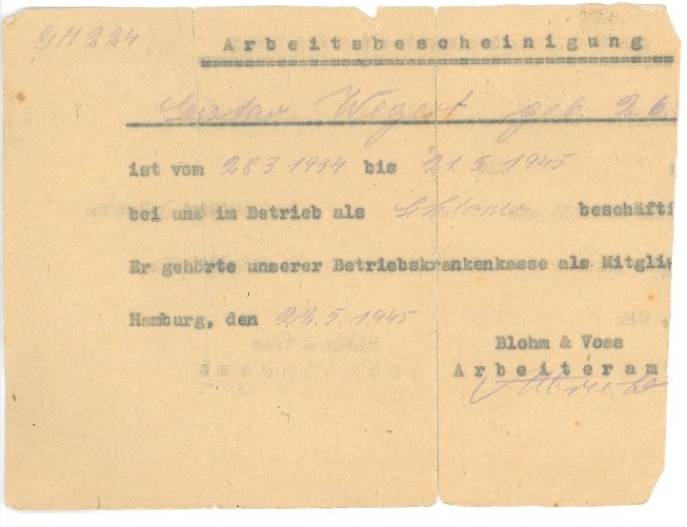1936 - Just one refused the Nazi salute

When in 1936 the dockyard Blohm & Voss slided the training sailing ship „Horst Wessel“ into the water, Adolf Hitler was there. Of course the employees greet the mandatory Nazi salute. But among the workers was a man who did not lift up his arm. Instead he crossed them in front of his breast. A picture later found shows the man and was published several times. Because people were curious who this worker could be, the newspaper „Hamburger Abendblatt“ appealed in November 1995 to its readers to give a report if they know the worker. On that November morning I was reading the newspaper and came across that picture. Without even reading the article I said to my surprised wife, that I discovered my father. After that I read the headline: „1936 – Just one refused the Nazi salute“. After I read the whole article I was convinced that I discovered my father Gustav Wegert. He worked as a metal worker for Blohm & Voss at the exact same time when the picture was taken. We still have the original certificate of his employment (Picture 5). Although there was no doubt for me I waited several days to see who else would answer to the appeal. Some days later the newspaper reported that the daughter of a man named August Landmesser believed to identify her father on that picture. In connection with this information the newspaper published the story of the persecution of Mr. Landmesser because of his jewish fincée. Deeply moved by this story I did not inform the newspaper, even though I was still convinced that the hero in that picture must have been my father.
Some years later I came in contact with the historian Dr. Simone Erpel and read in her manuscript „Zivilcourage – Schlüsselbild einer unvollendeten Volksgemeinschaft“ (see Gerhard Paul, „Das Jahrhundert der Bilder 1900 bis 1949, Vandenhoeck&Ruprecht 2009, Page 494), that the search for the man on the picture was without success, despite the report of the Landmesser family. Mrs. Erpel wrote this: „Irene Eckler (daughter of August Landmesser), who published the story of the persecution of her family in the publication „Die Vormundschaftsakte“ assumed that her father worked in 1939 for the dockyard Blohm&Voss as a prisoner. If he was engaged there at the time when the picture was taken in 1936 – before he was under arrest – is uncertain. Even though there are reasonable doubts, the presence of August Landmesser in that picture is considered as a fact.“
This information was interesting for us. Because if the employment of Mr. Landmesser at Blohm & Voss was only an assumption and not certain, the man in the picture could be my father after all. His general behavior during the time of the Nazis fits exactly to the worker in the picture. Both my father himself and my mother as well as many friends and a fellow worker told me again and again, that Gustav never raised his arm for the Nazi salute. From the beginning of the Nazi regime this was his basic principle. If someone greet him with „Heil Hitler“, he answered with a simple „Guten Tag“ (which means „Have a good day“). My mother told me often times about her anxiety that her husband could get imprisoned after he received several warnings. It was a miracle in her eyes that this did not happen.
My father told me also that Adolf Hitler not only came to the launch of the „Horst Wessel“ but also to other significant shiplaunches. To prevent a loss of production the propagandistic launches were placed on Sunday mornings. Because of that Gustav refused not only the Nazi salute but also his appearance and went according to the motto „you should obey God more than men“ to the Sunday morning service in his church.
He explained that no severe harm hit him from the Nazis because of his boss who summoned and warned him several times but covered him lightly. Qualified employees were necessary. Therefore Gustav was repeatedly requesetd by Blohm & Voss so that he never was enlisted to the front.
My family decided to make the story of my father known, since the interest about the couragous man in the picture is still huge. Dr. Simone Erpel writes the following: „In the meantime another Family from Hamburg has identified the man as a relative. It should be Gustav Wegert (1890-1959) who worked as a metalworker at Blohm & Voss. As a believing Christian he generally refused the Nazi Salute. Despite his distance to the Nazi Regime Gustav Wegert did not get in the eye of the Nazi persecution administration. Portraits from Wegert and Landmesser prove in both cases great similarity with the worker on that picture. At this time it has to remain unsettled who the man in the picture is“. (see Gerhard Paul, Das Jahrhundert der Bilder 1900 bis 1949, Verlag Vandenhoeck & Ruprecht 2009, Seite 494 rechte Spalte Absatz 3).
We join this assessment. But in any case we are deeply grateful fort the upright attitude of our father and grandfather during the time of the Nazi regime.
Wolfgang Wegert





(3) Gustav Wegert with his wife and son about 1948 - (private picture Wegert family)
(5) Original certificate of the employment of Gustav Wegert. He worked as a metal worker from 1934 to 1945 at Blohm & Voss in Hamburg (private picture Wegert family).
(4) Another picture of Gustav Wegert - (private picture Wegert family)
-
(1)Workers of the shipyard Blohm & Voss in Hamburg in 1936. Just one refused the Nazi salute.
(sz-photo)
(2) The worker in his refusing posture in 1936 - (sz-photo)